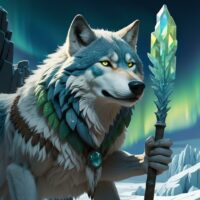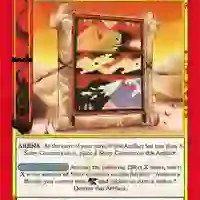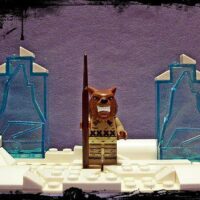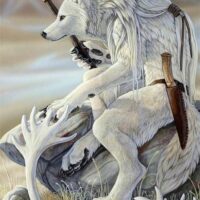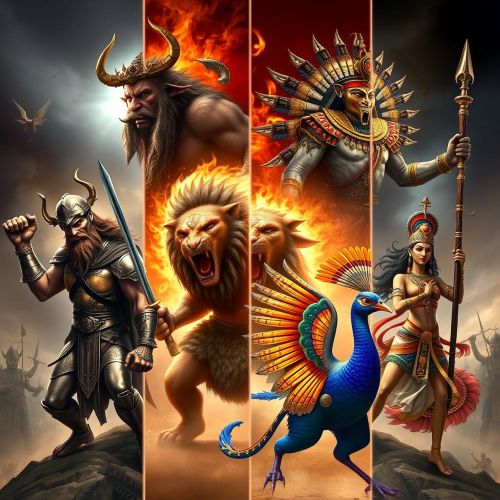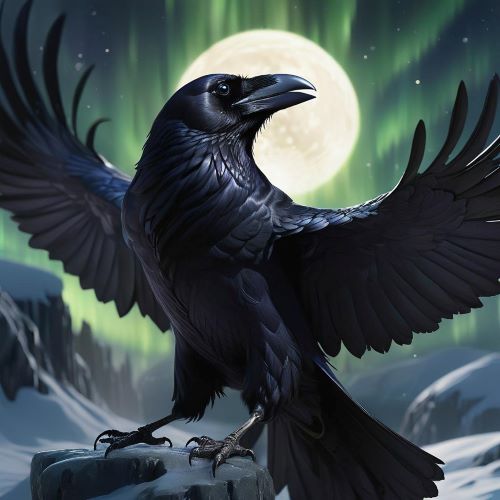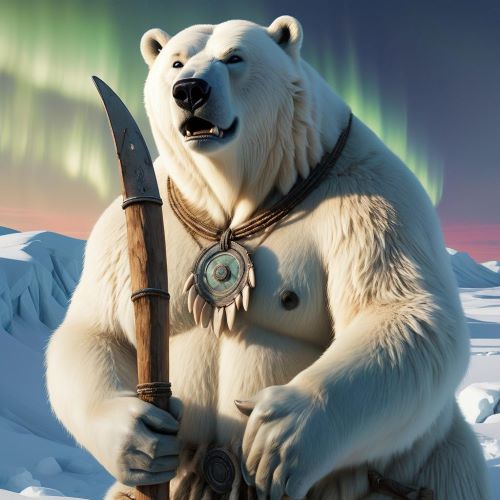Amaguq : God of Wolves
Listen
At a glance
| Description | |
|---|---|
| Origin | Inuit Mythology |
| Classification | Gods |
| Family Members | N/A |
| Region | Greenland, Alaska, Canada |
| Associated With | Wolves, Shapeshifting |
Amaguq
Introduction
Amaguq, derived from the Iñupiaq word for wolf, is a captivating figure in Inuit mythology, embodying the roles of a trickster and a wolf spirit. Within Inuit cultural practices, Amaguq holds a significant place, offering a unique perspective on their worldview. Renowned for his cunning and mischievous nature, Amaguq stands out as a prominent deity in Inuit folklore, symbolizing the cleverness and unpredictability of the natural world.
Physical Traits
Amaguq, known as a wolf spirit in Inuit mythology, embodies the physical traits of a wolf but is also a skilled shape-shifter, making it challenging to define its exact appearance. Typically depicted as a wily wolf or a man with wolf-like features, Amaguq’s appearance captures the essence of the wilderness, with fur as dark as the Arctic night and eyes that gleam like icy stars. His demeanor is sly and playful, reflecting his trickster nature. Stories describe Amaguq seamlessly transforming between human and animal forms, using this ability to navigate the Arctic landscape effortlessly.
The very name “Amaguq,” derived from the Iñupiaq word for “wolf,” hints at this creature’s primary form. In some tales, Amaguq appears as a massive, powerful wolf, larger than any ordinary animal, with fur that shimmers like the northern lights. His eyes are described as either piercing yellow, holding the wisdom of ages, or glowing red, striking fear into the hearts of humans. However, Amaguq’s most defining trait is his shape-shifting ability, allowing him to shift into human form at will and interact unpredictably with humans.
Family
Amaguq, a prominent figure in Inuit mythology and a wolf spirit, possesses the ability to shape-shift, making it challenging to pin down his exact physical characteristics. In his wolf form, Amaguq likely exhibits typical traits such as sharp teeth, keen senses, and a strong, agile body.
Within Inuit mythology, Amaguq is frequently depicted as the brother of Nanook, the polar bear god, and Sedna, the goddess of the sea. These familial connections underscore Amaguq’s significance within the pantheon, reflecting his role as both a sibling and accomplice in Inuit myths and legends. The Inuit pantheon is characterized by fluidity, with deities often sharing characteristics and domains, blurring distinctions between them.
Various stories link Amaguq to Sedna, portraying him as her brother or husband, while another association places him as the son of Qailerjutanlaq, the sky god. These relationships emphasize Amaguq’s deep connections to the natural world and the celestial realm, highlighting his multifaceted role within Inuit cosmology and spirituality.
Other names
Across the vast Arctic regions where the Inuit reside, variations in language and storytelling traditions have given rise to different names for Amaguq. Among the Inughuit of Canada, he is known as Qimmirq, which emphasizes his wolfish nature. In Greenlandic Inuit culture, he is referred to as Angutaalik, meaning “one who throttles.” Despite these varied names, they all refer to the same powerful entity governing the realm of wolves and embodying the concept of trickery.
In different Inuit regions, Amaguq is recognized by various names reflecting his cunning and resourcefulness. In some areas, he is called Amarok, synonymous with the great wolf spirit that prowls the tundra. In other traditions, he is known as Mahaha, a mischievous spirit luring unsuspecting travelers into the wilderness with laughter. These alternate names highlight the diverse interpretations of Amaguq within Inuit culture.
Amaguq is primarily known by this name in Inuit mythology, but it’s important to acknowledge that Inuit mythology spans various regions and tribes, each with their own dialects and mythological variations. Therefore, Amaguq may be known by different names across different Inuit communities, reflecting the rich tapestry of cultural diversity within Inuit lore.
Powers and Abilities
Amaguq, known for its shape-shifting ability, embodies the characteristics of a wolf spirit in Inuit mythology, symbolizing both the beauty and ferocity of nature. This transformative skill adds mystery and unpredictability to Amaguq’s character, typical of trickster spirits in various mythologies. Celebrated for cleverness and quick thinking, Amaguq outsmarts adversaries and navigates challenging situations with deep wisdom of the natural world.
As the leader of all wolves, Amaguq holds domain over their realm, possessing unmatched understanding of their behavior and the ability to call upon them at will. His shape-shifting allows seamless movement between human and animal worlds, providing a unique perspective. Amaguq, a trickster figure, delights in playing pranks on humans and spirits alike, ranging from playful to dangerous tests of wit and resilience. Some stories portray Amaguq as a bringer of storms and blizzards, reflecting the harsh realities of Arctic life.
Beyond chaos, Amaguq is also viewed as a guardian of hunters, maintaining balance between humans and nature. Hunters leave offerings to appease Amaguq, seeking his favor and respecting the power of wolves. This reverence for wolves as intelligent and powerful creatures stems from their association with this enigmatic deity. Amaguq embodies the intricate relationship between humans, nature, and the spiritual world in Inuit culture.
Modern Day Influence
The influence of Amaguq and Inuit mythology extends significantly into modern times, shaping cultural practices and beliefs among the Inuit people. Amaguq’s symbolism as a representation of wild, untamed nature continues to inspire various artistic expressions, including traditional carvings, sculptures, literature, and films. As a trickster figure, Amaguq inspires storytellers and artists to explore themes of adaptability, resilience, and the dynamic relationship between humans and nature, reflecting the complexities of life in Arctic regions.
In recent years, Amaguq has become a symbol of cultural revitalization and pride within Indigenous communities, with his stories and teachings being used to preserve traditional knowledge and strengthen connections to Inuit heritage and identity. Today, Amaguq maintains a significant presence in Inuit culture, appearing in various forms of artwork, carvings, and storytelling that emphasize the interconnectedness of the natural and spiritual worlds. The enduring respect for wolves, integral to the Arctic ecosystem, can be traced back to the reverence for Amaguq, influencing environmental movements advocating for wolf protection.
Beyond Inuit communities, Amaguq has permeated popular culture, appearing in fantasy novels, role-playing games, and video games that highlight his shapeshifting abilities and trickster nature. This widespread recognition of Amaguq underscores the enduring power and fascination of Inuit mythology, bridging ancient traditions with contemporary imagination and reinforcing the cultural significance of these ancient tales.
Related Images
Frequently Asked Questions
What is lorem Ipsum?
I am text block. Click edit button to change this text. Lorem ipsum dolor sit amet, consectetur adipiscing elit. Ut elit tellus, luctus nec ullamcorper mattis, pulvinar dapibus leo.
What is lorem Ipsum?
I am text block. Click edit button to change this text. Lorem ipsum dolor sit amet, consectetur adipiscing elit. Ut elit tellus, luctus nec ullamcorper mattis, pulvinar dapibus leo.
What is lorem Ipsum?
I am text block. Click edit button to change this text. Lorem ipsum dolor sit amet, consectetur adipiscing elit. Ut elit tellus, luctus nec ullamcorper mattis, pulvinar dapibus leo.
What is lorem Ipsum?
I am text block. Click edit button to change this text. Lorem ipsum dolor sit amet, consectetur adipiscing elit. Ut elit tellus, luctus nec ullamcorper mattis, pulvinar dapibus leo.
What is lorem Ipsum?
I am text block. Click edit button to change this text. Lorem ipsum dolor sit amet, consectetur adipiscing elit. Ut elit tellus, luctus nec ullamcorper mattis, pulvinar dapibus leo.

